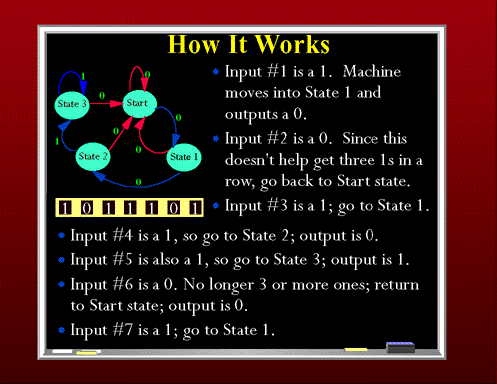The Turing Machine |

|
The machine starts off in the Start state. The first input is a 1 so we can follow the blue line to State 1; output is going to be 0 because three or more ones have not yet been read in. The next input is a 0, which leads the machine back to the starting state by following the red line. The read/write head on the Turing machine advances to the next input, which is a 1. Again, this returns the machine to State 1 and the read/write head advances to the next symbol on the tape. This too is also a 1, leading to State 2. The machine is still outputting 0's since it has not yet encountered three 1s in a row. The next input is also a 1 and following the blue line leads in to State 3, and the machine now outputs a 1 as it has read in at least 3 ones. From this point, as long as the machine keeps reading in 1s, it will stay in State 3 and continue to output 1s. If any 0s are encountered, the machine will return to the Start state and start counting 1s all over.
Turing's purpose was not to invent a computer, but rather to describe problems which are logically possible to solve. His hypothetical machine, however, foreshadowed certain characteristics of modern computers that would follow. For example, the endless tape could be seen as a form of general purpose internal memory for the machine in that the machine was able to read, write, and erase it--just like modern day RAM.
Computers: From the Past to the Present
The Turing Machine:
Last modified July 30, 2006
©1994-2006 by Michelle A. Hoyle